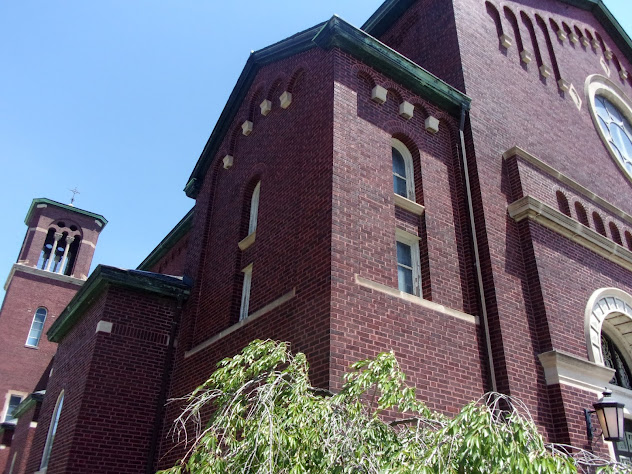Saint Monica
Mishawaka Indiana
One of three ethnic parishes in Mishawaka, Saint Monica's sits in the formerly Italian neighborhood of North Mishawaka, just off of downtown. Designed in an Italian style this parish was the embodiment of the Italian presence in Northern Indiana for many years.
The bell tower is one of two signs that this church is Italian. As mentioned in Saint Thomas, Italian churches usually have bell tower, baptistry, and church as three independent entities. While this is not the exact case, having the bell tower set back in the church, as compared to having it up front, is still Italian. The other is the heavy use of marble in the interior around the sanctuary.
Without having the bell tower by the façade, the church front also looks very typical Italian by having three entrance portals and a rose window above. To the right is Saint Monica's school, dedicated May 13th 1917, the same day as the first Fatima apparition.
What strikes me odd about this church is the unusually tall chimney. If you look closely where it starts to taper, you can see the brick changes colors. Thus, the stack was once shorter.
Part of the façade and bell tower. Within the tower, the original bells reside, but unfortunately are not rung due to fear of damaging the old stained glass. Thankfully strengthening efforts are being taken, thus there is hope that the bells may ring again.
The dedication/corner stone. This church had the unique juxtaposition to be a "modern" church, while at the same time was built just before the financial crash of 1929, aka the great depression. Had the church been built during the depression, it would have been much simpler. Had it been built after the depression, it likely would have had to wait for WWII and then it would have been built in a much uglier style as modernism was beginning to take effect. In short, the late twenties were the last hurrah of beautiful church architecture.
The façade is a local landmark in Mishawaka, as it sits in a prominent place, just across the Saint Joe River. This church is also a hotspot for weddings at just across the street in a local park. Many photos have been taken there, with this church in the background.
The doors are an interesting feature. Usually doors like this are additions in the sixties; however, the engraved images are far too detailed to be from the seventies/sixties. Thus, I am at a loss for the exact date these doors were installed.
The interior of the church has a very heavy blue aesthetic, and the stained glass only helps to accentuate this color. The hard floor makes for a very heavy echo effect, especially when microphone/speakers are used.
The pews and wood floor underneath are well worn, a sign of their originality. The arches along the walls mistakenly appear to be lower than they seem. This gives an awkward sense of the church being lower, or the floor being too high along the aisles.
The body of the church. Along the walls of the nave are flower patterns. The ceiling is a blank canvas for future frescoes. The pews are quite long, perfect for accommodating school children attending daily Mass.
A close up of some of the ground level stained glass. The glass was obtained by many of the parishioners, while several also obtained the marble for their main and side altars, as well as the high altar at nearby Saint Joseph Church.
Side altar of Our Lady. The reredos around the Blessed Mother are quite simple, but the simplicity adds to the beauty of this corner. It is also very pleasant to see the altar decorated with flora. It adds a level of balance and proportion to the altar.
The main Altar. The only Vatican II change to the sanctuary is new seating, and the altar has been brought forward. While some churches have/had a canopy over the altar, this church has a step above and an official baldacchino, (A freestanding ceremonial stone canopy). This is the only parish, (but not the only church) in the diocese to have such an item.
The side altar of Saint Josaph. One nice detail added to both this, and the Marian altar are the initials of each parent of the Holy Family. Also note on the altar, the Mass part plaques for the celebration of the Traditional Latin Masses. (Private Masses now, with Traditiones Custodes)
A side shrine to the Pieta. The dark color of the wood contrasts well with the light blue of the church.
The stained glass was most likely imported from Europe, (Germany, most likely?)
Lastly, the baptismal font was moved from it's original room and now sits in the back of church. The room was converted into a bathroom.






















No comments:
Post a Comment